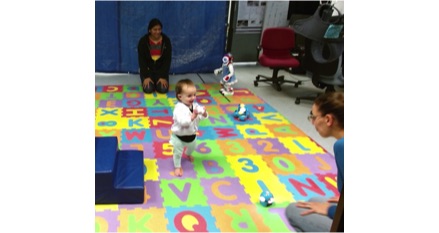Overview
This project is essentially a natural extension of our earlier work on GEAR: Grounded Early Adaptive Rehabilitation, but now we are pushing the envelope in three distinct scientific directions: (i) bringing more accessible robotic technology closer to families' homes, (ii) challenging the prevailing paradigm on robot swarm control, and (iii) using direct electroencephanography (EEG) feedback from the infant to the swarm in order to regulate their interaction.
In this project, we are creating a new enriched pediatric rehabilitation environment, where a small swarm of toy-robots interact with infants in the context of play-based activities. Our hypothesis is that appropriately designed and regulated swarm motion
behaviors can keep infants engaged in active game play.

The research plan expands along four technical axes: (i) the design of cooperative swarm behaviors tailored for child-robot interaction, (ii) the development of efficient multi-target perception and tracking algorithms, (iii) the production of EEG signal processing techniques that will enable robots to assess human engagement, and (iv) the integration of the technology into new enriched rehabilitation environments which can quantitatively assess intervention outcomes.
Scientifically, we target contributions for new intervention patheways for neuroplastic and neuromascular changes in developing children, new mathematical architectures for regulating human-swarm interaction, and quantitative neurophysiological metrics for infant engagement with highly mobile and interactive smart toys.
Outcomes
Find additional information and publically available research outcomes at the project's open science workspace.
Funding Organization: NSF
Duration: 4 years
Total Budget: $1,099,399
Participants: UD
